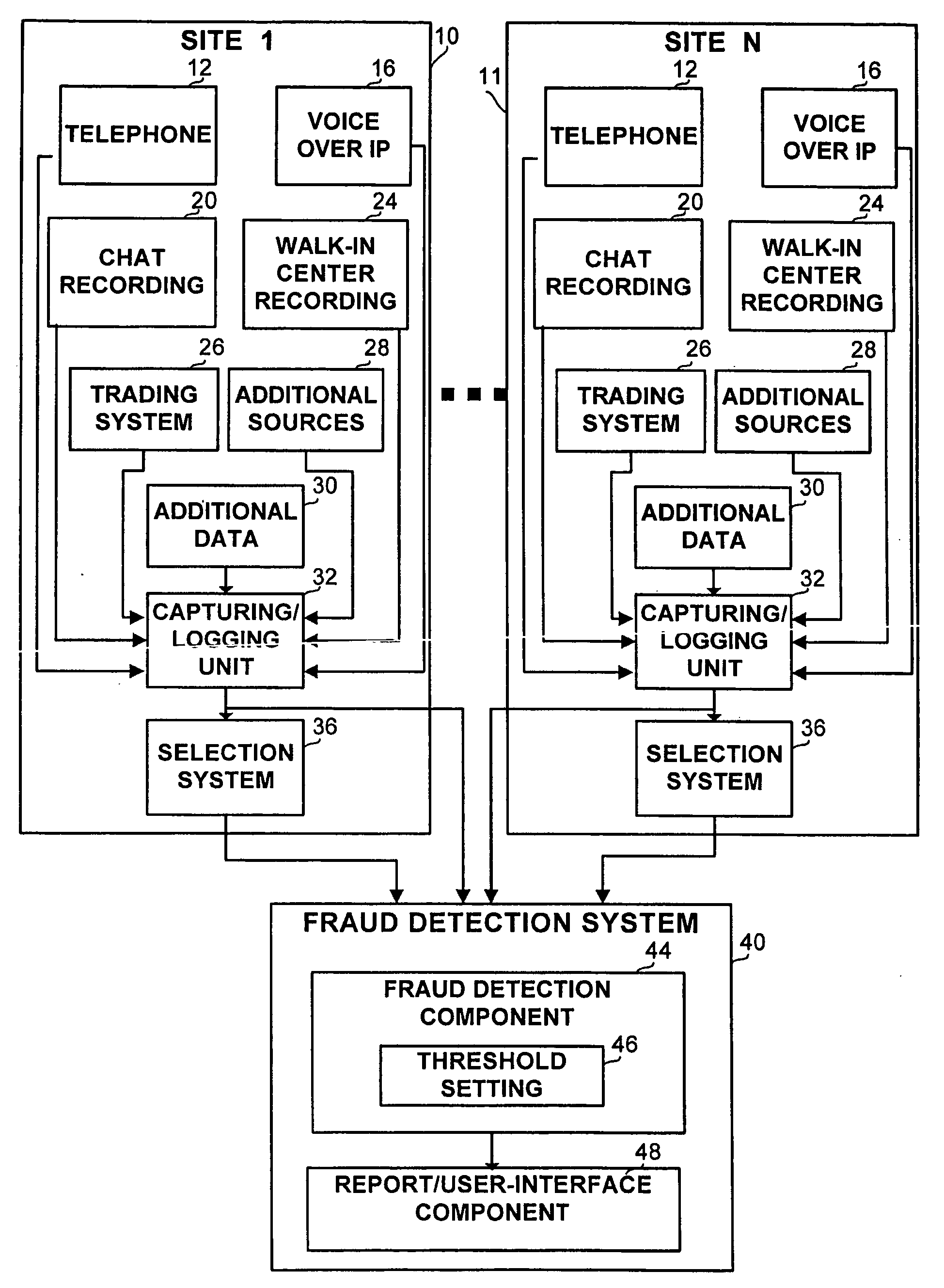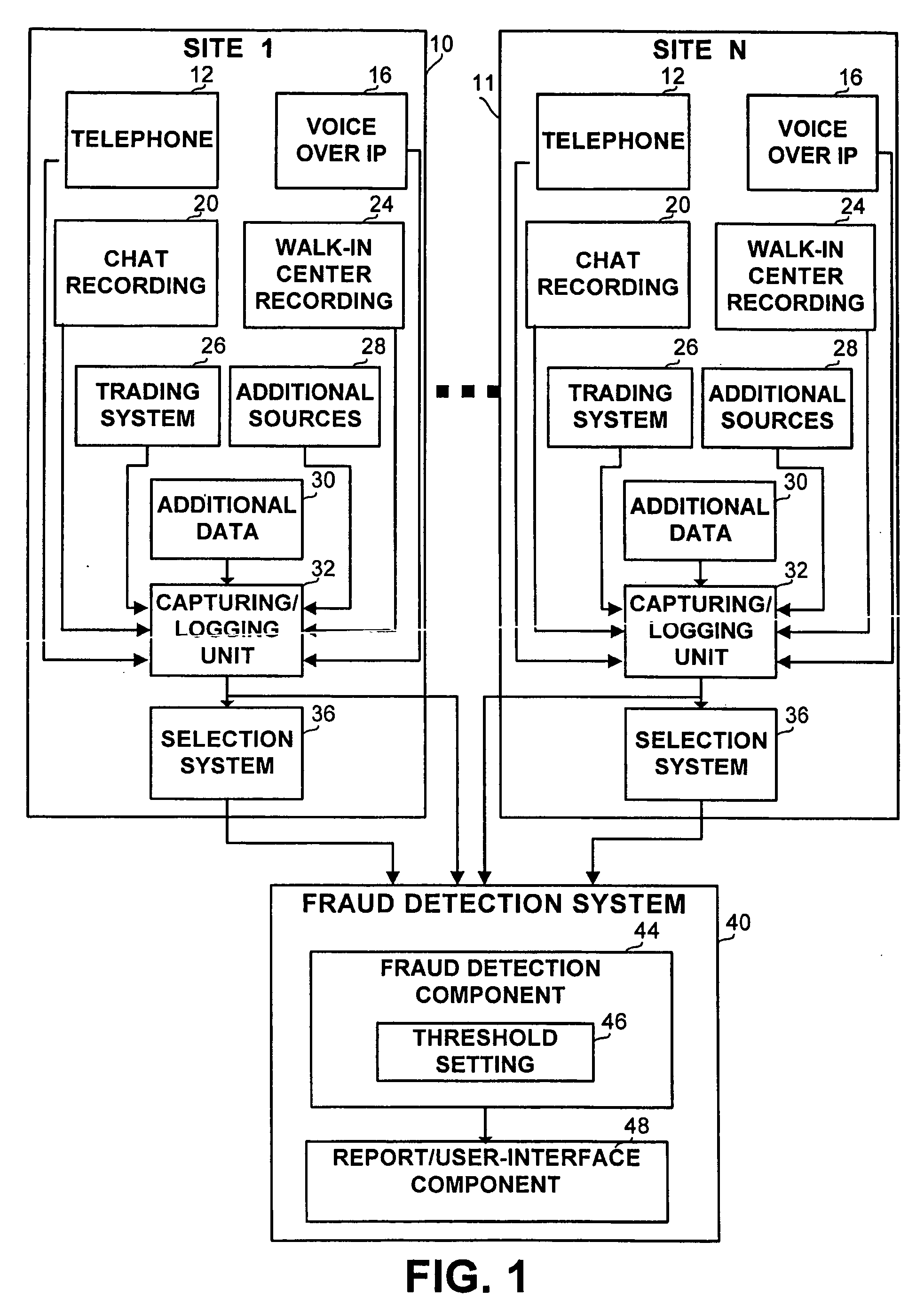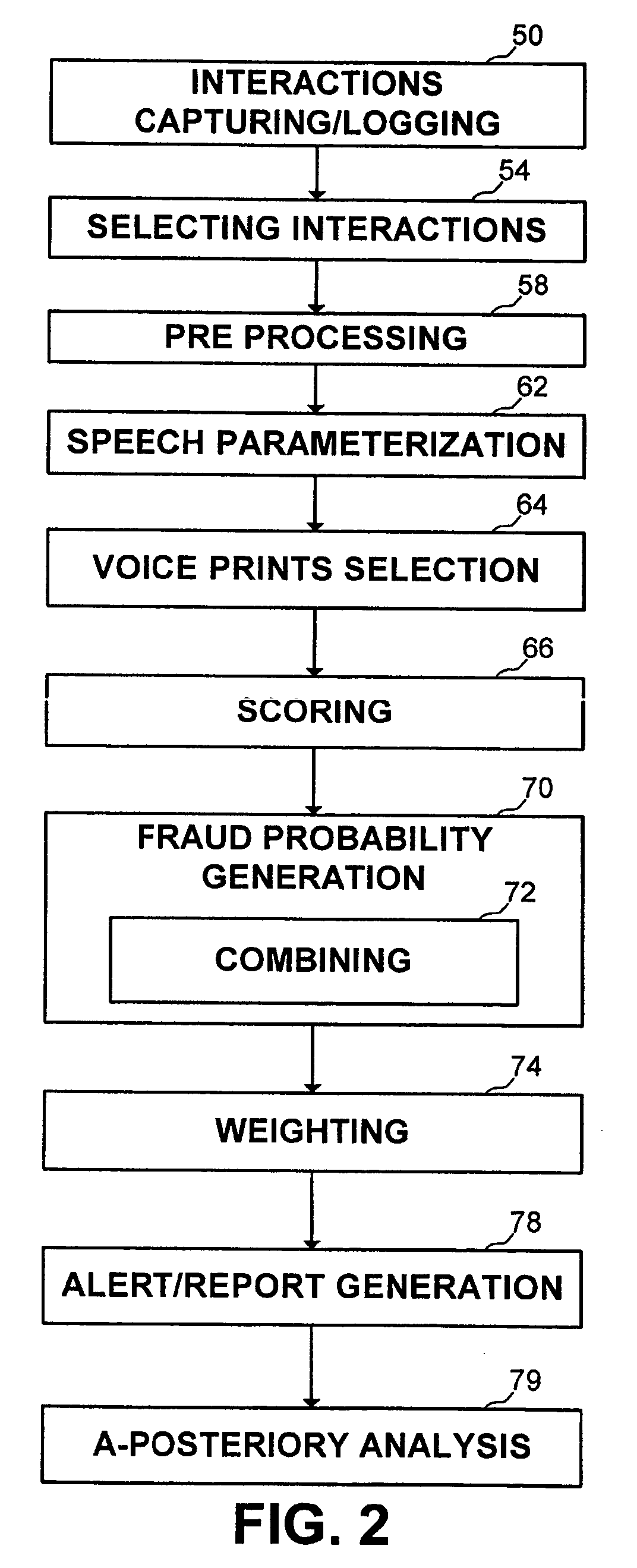[0006] It is an object of the present invention to provide a novel method for an apparatus and method for detecting interactions capturing fraud attempts which overcome the disadvantages of the prior art. In accordance with the present invention, there is thus provided a fraud detection method for generating a first fraud or fraud attempt probability, within one or more captured or recorded interactions, the method comprising the step of scoring one or more voices belonging to one or more tested speakers in the captured or recorded interaction against one or more voice prints within one or more entries in a voice print collection, the scoring step generating a probability that the one or more voices in the captured or recorded interaction belong to one or more second speakers associated with the one or more voice prints, said probability represents the probability that the one or more captured or recorded interaction is fraudulent. Within the method, the probability generated at the scoring step represents the similarity between the voice of the tested speaker and the voice of the at least one second speaker, said second speaker can be a fraudster, a legitimate speaker, or allegedly the tested speaker. The method further comprising a fraud probability generation step, for enhancing the first fraud or fraud attempt probability. The fraud probability generation step employs a rule engine activating one or more rules or using one or more thresholds set by a user of the method. The rules or the thresholds can involve data associated with: the captured or recorded interaction, a speaker thereof, an at least one other interaction of the speaker thereof, the one or more voice prints or the one or more second speakers. The rules or the thresholds can be set dynamically. The method can further comprise: a second scoring step for determining a second scoring result by scoring the one or more voices against a background model; and a normalizing step for normalizing the first scoring result with the second scoring result. Within the method, the scoring step can comprise scoring the one or more tested voices against two or more voice prints, thus obtaining two or more score results. When scoring against two or more voice prints, the method can further comprise a score-test normalization step, for normalizing the at least two score results. Within the method, one or more voice prints or data associated with the voice prints or with the second speaker is stored in a collection. The method can further comprise a retrieving step for retrieving one or more second interactions, and a construction step for constructing the at one or more voice prints from the one or more voices participating in the one or more second interactions. The method can further comprise a step of retrieving one or more voice prints or data associated with the one or more voice prints. When retrieving a voice print, the method can further comprise a filtering step for filtering a collection to retrieve the one or more voice prints such that data associated with the voice prints is related to data associated with the recorded or captured interaction. The filtering can be based on an at least one of: area code of calling number, gender of speaker, age pf speaker, language spoken. The step so of the method can be performed in real-time. The method can further comprising a pre processing step for pre processing the captured or recorded interaction or the second interaction. The pre processing step can comprise one of: compressing; decompressing; segmenting; separating speakers; identifying the agent side; and receiving data related to the captured or recorded interaction or to the second interaction. The additional data can comprise computer telephony integration information. The method can further comprise a selection step for selecting one or more selected interactions to be transferred to the scoring step, and associating the one or more selected interactions with one or more second fraud or fraud attempt probabilities. Within the method, the selection step can comprise one or more of the following: applying one or more rules by a rule engine; auditing interactions; filtering interactions using one or more filtering engines. The filtering engines can comprise one or more of the following: emotion detection, word spotting, speech to text, interaction analysis, and data risk analysis. Within the method, the second fraud or fraud attempt probability represents a risk level associated with the one or more selected interactions. The selection step can employs one or more rules or one or more thresholds set by a user of the method. The rules or thresholds can involve data associated with one or more of the following: the captured or recorded interaction; a speaker thereof; other interactions of the speaker thereof; the one or more voice prints or the at least one second speaker. The one or more rules or one or more thresholds can set dynamically. The method can further comprise a weighting step for generating a combined fraud attempt probability from the first and the second fraud attempt probabilities. The method can further comprise an alert-generation step for generating an alert if said first fraud or fraud attempt probability or said second fraud or fraud attempt probability or a combination thereof exceeds a predetermined threshold. The alert can be sent to an agent or another contact associated with the captured or recorded interaction. The method can further comprise a reporting step for generating or updating a report comprising details of the one or more captured or recorded interactions if the first fraud or fraud attempt probability or the second fraud or fraud attempt probability or a combination thereof exceeds a predetermined threshold. The method can further comprise an auditing step for auditing the report. The auditing step can comprise one or more of the following: listening to calls; reviewing interactions; reviewing history of one or more speakers participating in one or more interactions; listening to previous interactions of speakers participating in one or more interactions appearing in the report, or filling forms. The method can further comprise a step of interaction capturing or logging. The method can further comprise a step of a-posteriori analysis for one or more of the following: adapting one or more parameters or one or more rules or one or more thresholds used by the method, trend analysis, pattern of behavior recognition, selecting one or more filtering engines.
[0007] Another aspect of the disclosed invention relates to a method for constructing a voice print collection, the method comprising the steps of: receiving one or more suspect voice samples; extracting characteristic features from the one or more voice sample, thus generating one or more sequences of feature vectors; constructing a voice print from the one or more sequences of feature vectors; and storing the voice print in a collection. The method can further comprise a storage step for storing data in the collection, said data associated with the at least one voice print, or with the at least one voice sample, or with an at least one speaker participating in the voice sample. The method can further comprise a normalization step for generating score normalization parameters to be used when scoring one or more voice samples against one or more voice prints from the collection
[0008] Yet another aspect of the disclosed invention relates to a fraud detection apparatus for generating a fraud or fraud attempt probability, within one or more captured or recorded interactions, the apparatus comprising: a voice print collection comprising one or more entries, each entry comprising a voice print or data associated with the voice print, said voice print is constructed from a voice known or suspected as belonging to a fraudster; and a scoring component for scoring one or more voices in the captured or recorded interaction against the voice print within the one or more entries, the component generating a probability that the one or more voices in the one or more captured or recorded interaction belong to one or more persons associated with the one or more voice prints, said probability represents the probability that the one or more captured or recorded interaction are fraudulent.
 Login to View More
Login to View More  Login to View More
Login to View More 


